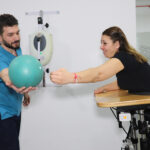Pelvic Floor Rehabilitation
WHAT IS PELVIC FLOOR REHABILITATION?
Pelvic floor muscles provide support to the bladder, intestines, uterus in women and prostate in men. Therefore, a malfunction in the pelvic floor muscles prevents these organs from functioning properly. At the same time, disorders in these organs cause dysfunction in the pelvic floor muscles.
Pelvic floor rehabilitation is a treatment method aimed at optimizing pelvic floor muscle function. The goal in rehabilitation is to ensure that the muscles work in a balanced and coordinated manner. It is a method applied by expert therapists in this field.
Pelvic floor muscles are affected during pregnancy, birth and menopause in women. Prostate problems in men cause pelvic floor disorders. In addition, abdominal-genital area surgeries, excess weight, and diseases that cause chronic cough can cause pelvic floor problems. During these periods, pelvic floor rehabilitation helps to eliminate problems in disorders that occur.
What are the Benefits of Pelvic Floor Rehabilitation?
- Provides regulation of pelvic floor muscle functions.
- It increases the circulation of the pelvic floor area.
- It provides regulation of waist, hip and respiratory functions.
- It provides the regulation of urine and stool functions.
- It helps to eliminate sexual disorders.
- It improves the life quality.
What are the Application Areas of Pelvic Floor Rehabilitation?
- Frequent urination: Urinating more than 7 times a day is not normal and requires treatment.
- Incontinence: It means urinary or fecal incontinence. Coughing, laughing, sneezing, or incontinence while exercising are not normal.
- Difficulty passing urine / feces: Not feeling full relief during the discharge process means that the discharge process is not complete. In addition, it is not normal to feel pain during the discharge process and to discharge with a long effort.
- Bed wetting at night: Bedwetting at night is not normal in children after the age of 5.
- Constipation: Defecating less than 3 times a week is an indication of constipation. Feeling pain during defecation, inability to provide complete discharge, excessive straining are other signs of constipation.
- Chronic pelvic pain: It is the pain felt in the lower abdomen, waist, hip and genital area. This may be caused by musculoskeletal disorders in the area. Endomtriosis is a common condition in painful menstruation.
- Painful sexual intercourse / Vaginismus: Inability to have sexual intercourse or pain during sexual intercourse. Tense pelvic floor muscles can cause this condition.
What Are Treatment Methods In Pelvic Floor Rehabilitation?
- Patient training
- Pelvic Floor Exercises
- Manual Therapy
- Biofeedback applications
- Electrical stimulation
Who is Pelvic Floor Rehabilitation Applied to?
Pelvic floor rehabilitation can be applied to all patients with pelvic floor problems. The methods used in women, men and children are different from each other. Treatment is applied by determining the appropriate methods for the age, gender and clinical condition of the person. In addition, neurological patients also benefit from treatment.
How is Pelvic Floor Rehabilitation Performed in ROMMER?
In our center, pelvic floor rehabilitation is applied to patients diagnosed by a specialist physician. The patient coming for treatment is evaluated in detail and an individual treatment program is created for the patient. The treatment is started by determining the appropriate methods for the needs of the patient. The treatment program is constantly revised in accordance with the progress of the patient.

